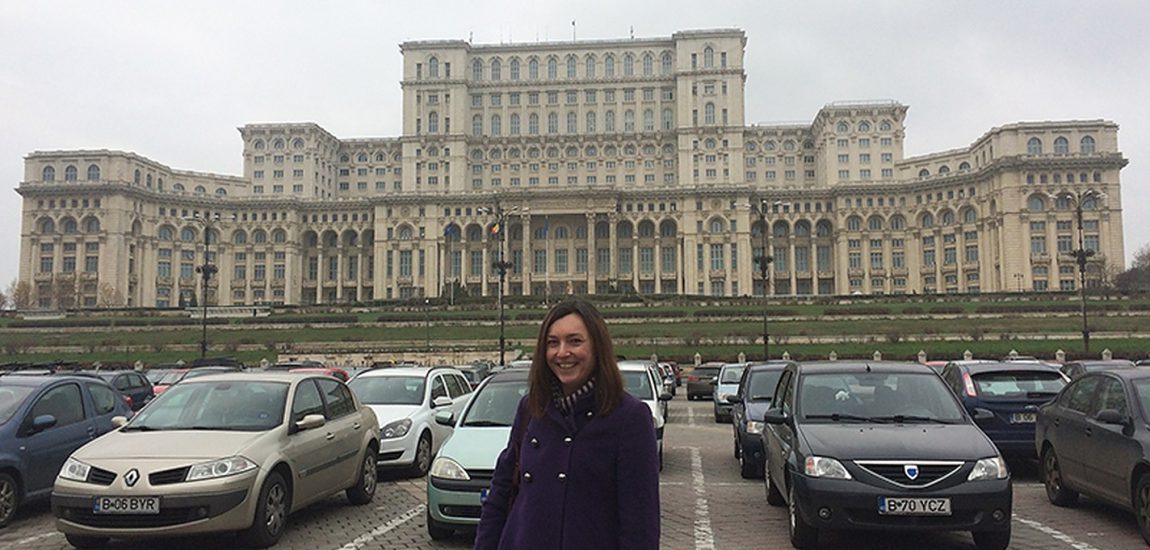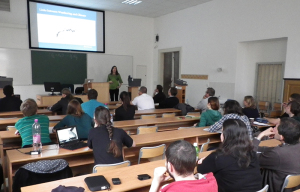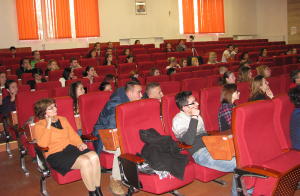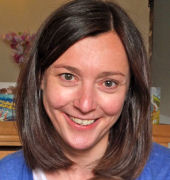
Wonders of the East

It was a surprise and honour to be asked to deliver the EAG Distinguished Lecture Tour 2014, and to be given the opportunity to connect with Geochemists working in Eastern Europe. In recent years my research has focused on applying an isotope geochemistry toolkit to a range of environmental issues, from assessing the links between gas hydrates, climate change and methane emissions from the seafloor in the Arctic, to quantifying the impacts of seepage of carbon dioxide from sub-seafloor storage sites on the marine environment, to evaluating the utility of light stable isotopes as tracers of weathering processes. Interest in these topics was expressed by research institutes and university departments specialising in Biology through Environmental Science & Engineering, as well as Geology.
Having swiftly modified the introductions to my lectures to accommodate this diversity, my tour kicked off with my first ever visit to Prague, hosted by Dr Juraj Farkas from the Czech Geological Survey. My talk was given at Charles University, enabling not just Survey staff but also University staff and students to attend. It turned out to be a wonderful opportunity to catch up with lithium isotope colleagues of old, and to make new acquaintances interested in applying isotope techniques to trace groundwater pollution. Juraj kindly took the time to also acquaint me with the old Town, Charles Bridge and of course a brewhouse; but thankfully no English stag parties.
The remainder of my tour took place in a week-long hit, having re-arranged teaching, PhD student initiations and nursery pick-ups, at the end of November. Woollen overcoat retrieved from the attic, I set off for Bucharest where I was met at the smart new airport terminal by Dr Cristina Sandu from the Romanian Academy Institute of Biology. We made a swift tour of the city, taking in the Arcul de Triumpf and history museum as well as the balcony from which the Ceausescu’s departed.
The next morning I toured the Institute’s impressive microbiology facility, and gave 2 lectures before meeting with the Director of the Romanian Academy of Sciences. I was delighted to learn that the Academy is refurbishing its Research Station on the Danube delta, and hope that I will work there with my team in the near future. After a whistle-stop tour of the Geological Museum, with its fantastic collection of indigenous Romanian dinosaurs, and Ceausescu’s triumphant palace, I set off over the snow-covered mountains for Cluj-Napoca.
I confess I had to Google Cluj when I learnt I was to travel there, and was intrigued to discover it was the haunt of Count Dracula and Vlad the Impaler as well as host to Romania’s largest University, Babes-Bolyai. My host, Prof. Calin Baciu, filled me in on other aspects of Cluj history, before we took off to a fascinating ceremony to award an honorary doctorate to the Romanian astronaut, Dumitru-Dorin Prunariu. After the reception, fuelled by Cinzano, I gave two particularly well-attended talks to staff and students in the Faculty of Environmental Science and Engineering (you can watch the video of the lecture “Weathering, ocean chemistry and climate change: New insights from non-traditional metal stable isotopes” below).
Then it was on to Sofia, after a short delay to clear snow from the runway. I was sped to the heart of the city by Dr Momchil Dyulgerov from the Department of Mineralogy, Petrology and Economic Geology at Sofia University, to spend a relatively balmy evening (1 ˚C compared to -4 ˚C in Cluj) taking in the sights. The next morning I gave my lectures in the University’s spectacular main building, spending time in particular debating the use of isotopes in palaeoenvironmental studies. Then after a tour of Sofia’s baroque cathedral, it was time to depart for home via gloomy fog at London Heathrow.
I’d like to extend my warmest thanks to all of my hosts, for making me most welcome and taking the time to show me the sights, discuss science and meet their colleagues. I’d also like to thank Marie-Aude Hulshoff for ensuring a smooth and painless journey, and the EAG for affording me this opportunity.

About the author

Rachael James is Associate Professor in Marine Geochemistry at the University of Southampton. Her research focuses on the development and application of chemical and isotopic techniques to improve our understanding of earth and planetary processes- both now and in the past.
Find out more about EAG the Distinguished Lecture Program.
